In the game since 1988, Göweil is an Austrian-based manufacturer whose products are held in high regard. The firm has a reputation for building high-quality strong machines, which are sometimes even described as being over-engineered.
In years gone by, Göweil had a presence in the Irish combi market. However, they would have been seen coupled to another manufacturer – mostly Lely Welger. In such cases, the likes of the Welger baler would slot into the Göweil combination frame, which came equipped with a wrapping unit. However, shear lack of dealer representation in Ireland would have withheld many interested parties from making the move to the Austrian built kit in more recent times.
It was 2016 before the first new Göweil combination baler was imported into Ireland.
It was brought in direct from the manufacturer by two brothers who run a contracting business in Co Cork. Three years ago in 2020, the Cooney Furlong Machinery Company in Co Wexford was announced as the sole Irish importer for Göweil.
Since then, the brand has been making inroads into the Irish market with balers, wrappers, bale slices and of course the combi unit. To find out what the fuss is about, we put a new G-1 K125 combination baler/wrapper unit through its paces over the summer months. 
Dual binding is an innovative feature which was introduced several years ago from Goweil.
First impressions
At first glance, the G-1 K125 seems to be savage well built. You couldn’t help but be drawn towards the huge triplex drive chain and the large diameter roller shafts. Build quality is consistent right through, and you just know it’s going to weigh in heavier than most competitors just by looking at the machine. The first reservation I had was whether or not the wrapping table and the pickup reel had enough ground clearance, and how quick the bale transfer would be. 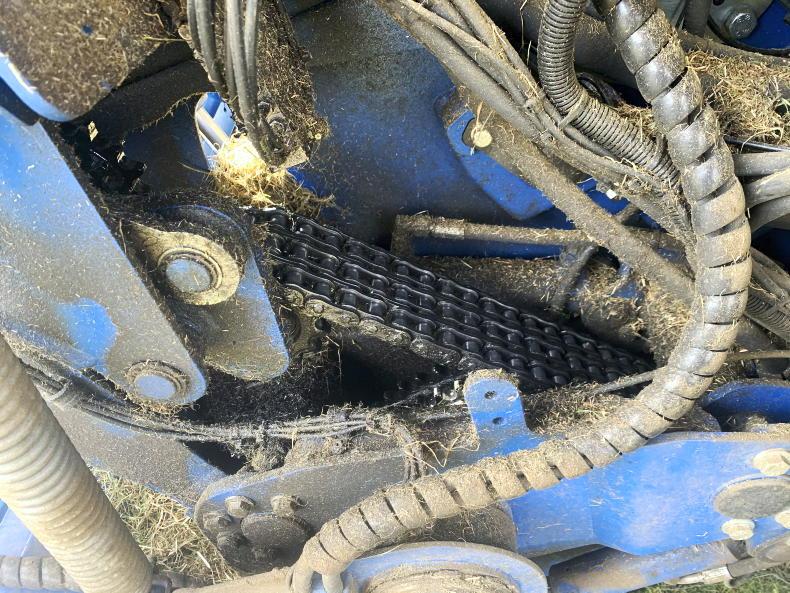
Goweil use a triplex chain to drive the main rotor, in comparison to many competitor machines who use duplex chains.
Pickup and rotor
The baler is fitted with a 2.2m-wide pendulum-type pickup with a swing range of 150mm, almost designed like many of the new forager headers. The camless pickup has six tine bars and is fitted with heavy-duty tines, all of which are spaced at 51mm. The bands on the pickup are plastic, which the manufacturer says makes them more durable and less prone to bending.
The unit is fitted with two crop press rollers, which work well to help smoothen out lumpy or uneven swaths. The small guide wheels on the pickup remain within the baler’s overall width, meaning they don’t need to be folded in or removed for transport.
Sitting very closely behind the pickup is the six-star 570mm rotor with welded-on Hardox tines. Having operated the machine, its snug fit close to the pickup means there’s no evidence of a dead spot where grass may potentially build up and block the rotor.
In front of the rotor is a small in-feed roller to help pre-compress the crop. The rotor on the previous Göweil machine was hydraulically driven, while the latest machine is now mechanically driven and hydraulically assisted.
The Auto Flow Control (AFC) feature monitors the flow of crop and intervenes automatically in the event of a blockage. The top door above the knives opens, the knives rise out of the working position, allowing the blockage/lump to pass through before resuming their previous position.
Similarly, in the event of the pickup blocking, the hydraulically assisted infeed rotor will switch to hydraulic drive, the drop floor will open and the lump will be fed into the chamber. The beauty here is that the PTO does not have to be disengaged. Instead, it’s just a matter of dropping the tractor’s engine rpm, allowing the baler to swallow the lump, and off you go again. It saves time rather than having to restart the PTO, drop the floor, take in the lump and raise the floor again before you can get moving, as is the case with many machines. 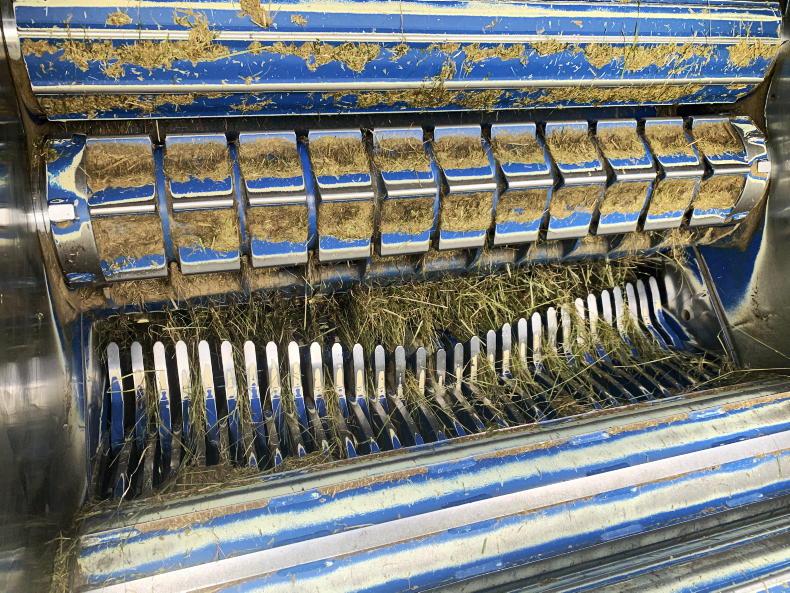
The bale chamber is home to 18 solid, ribbed rollers which are made using 4mm-thick steel with inner reinforcing.
Chopping system
The Göweil is quite similar to the Pöttinger Impress combi baler in that both machines have the cutting unit positioned above the rotor.
This means that the crop is fed up and over the rotor instead of under it like most balers on the market. One of the advantages of this particular design is that the changing of knives is a lot easier. In fact, I know of one contractor who actually bought a new Göweil baler solely for this reason. It means that the knives can be easily changed while standing on the same platform which is used to load the net/barrel wrap. This is a brilliant design. The last thing any farmer or contractor wants to do after a long day’s work is to lie under a baler changing knives, with chaff and dust falling on top of them. The knives can also be changed without the need for any tools.
The knives can also be changed without the need for any tools.
The cutting unit is fitted with 30 double-sided knives capable of producing a theoretical chop length of 35mm.
The replacement knife bar allows up to 30 spare knives to be carried. From our experience, the chopping system appeared to have been doing a very nice job. The knives are hydraulically protected in the event of a contacting a foreign object.
Once netted, the bale is quickly transferred from the chamber to the twin arm satellite wrapper table.
Bale chamber
The bale chamber is home to 18 solid, ribbed rollers which are made using 4mm-thick steel with inner reinforcement. Meanwhile, two drive rollers with 65mm shaft diameters and the additional rollers each with 60mm diameter shafts run on double-row pendulum roller bearings. Located just behind the rotor is the starter roller, which is different as it has a sectioned profile. Göweil claims that this allows for good bale rotation early on. The last roller on the rear door of the 1.2m x 1.5m chamber is completely smooth, which is to help with the transfer of film-binded bales.
Many of the drive chains, in particular the primary drive chain, are stronger than the previous machines. The obvious standout here is the triplex chain which is used to drive the main rotor, in comparison to many competitor machines that use duplex chains.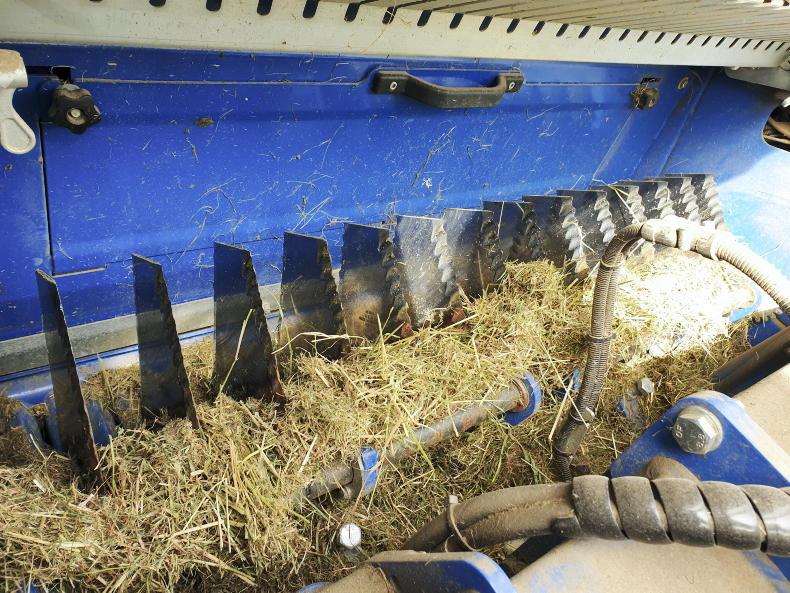
One of the advantages of this particular design is that the changing of knives is a hell of a lot easier than conventional balers.
Dual binding
Dual binding is an innovative feature which was introduced several years ago from Göweil.
The dual binding units essentially do what they say on the tin, and either apply net or NRF (net replacement film) to the finished bale simultaneously via two applicators, reducing the binding time by half. However, by doing so with NRF, you tend to have a little more film wastage, as you have two tails of film as opposed to one.
We can see the option being a serious addition for contractors who are frequently switching between standard net and NRF binding.
This has turned into a common situation for many contractors across the country.
If you were using just the one binding unit at a time, but keeping a full roll of NRF and net in each dispenser, it would be possible to switch binding units in 20 seconds using the terminal. From the time we spent with the baler, we found that the NRF film application worked well.
Wrapping unit
The unit features a twin-arm satellite wrapper, which would be a familiar sight for a share of Irish contractors.
Göweil previously built universal wrapper units to fit various different balers as well as standalone versions, with examples of each still dotted across the country.
Once netted, the bale is quickly transferred from the chamber to the wrapping table.
The wrapping table moves closer to the chamber via a chain driven track.
The transfer system is not the fastest on the market, but it was smooth and very reliable.
One reservation we would have is that the bottom of the angled track which the wrapping table runs on is very low to the ground.
In fairness, these machines are manufactured to work on very steep ground, as is common in Austria. So, as they say, it’s horses for courses.
Chassis
The combination unit is heavy, weighing in just shy of 9,000kg unladen. Not only is it heavy, but it’s quite wide also, clocking in at an overall width of 3m on the standard 560/45 R22.5 tyres. The option of a steering axle is currently not available.
For those who would desire a wider footprint, 710/35-R22.5 tyres are an option, but they increase the vehicle width to 3.30m – so realistically this isn’t a runner for the vast majority in Ireland.
The high weight and the vehicle width even on the 560mm tyres may leave the viability of this machine questionable as a front-line machine for contractors in some parts of the country.
A nice feature is the hydraulic weight transfer system on the baler’s rear axle.
If engaged, more weight is placed on its rear axle hydraulically to increase the weight on the tractor’s drawbar. This is to improve traction in difficult conditions. The unit has a hydraulic drawbar which makes dealing with gaps easier.
The machine features enclosed hydraulic side panels that can carry 14 wrap rolls and two net/film rolls. This large carrying capacity will be appreciated by contractors.
Controls
Göweil is offering the unit with IsoBus as standard, or it can be specified with one of two touchscreen control displays (4.3” or 7.0”). We operated it through IsoBus on a Case IH Puma 185, which worked flawlessly.
The interface control was clear and crisp and the camera system offered a good view of the work flow.
However, we felt it took some time to get to grips with the control layout, and that it maybe wasn’t as clearly presented as some of the other manufacturers on the market.
Hats off to the Austrians, the build quality of the Göweil can only be complimented. However, this also brings negatives to the table. To be honest as a contractor in the west of Ireland, I would be worried about the weight of the machine, particularly if we got a difficult summer weatherwise. On marginal ground, the weight of the baler coupled with limited ground clearance could be a bad combination.
However, the machine encompasses a host of super features. The chopping system, the dual binding and the blockage release system are all well thought out. Overall, the Göweil K-125 is a super piece of kit, but comes at a hefty price, which is in the region of 20% more expensive than most competitors on the market.
At the end of the day, machine pricing always plays a large role on machines’ influence on the market, so time will tell how well the Göweil kit will sell in what is a very competitive sector at But one thing is for sure, its a seriously well engineered piece of equipment.
Model: G-1 F125 Kombi.
Knives: 30.
Rollers: 18 rollers (4mm thick) with 60 and 65mm shafts.
Net capacity: Four rolls (two in use, two spare).
Film capacity: 16 rolls (two in use, 14 spare).
Weight: 8,980kg empty.
Width: 3m (9.5ft).
Wheel size:
List price: €130,000 plus VAT.
In the game since 1988, Göweil is an Austrian-based manufacturer whose products are held in high regard. The firm has a reputation for building high-quality strong machines, which are sometimes even described as being over-engineered.
In years gone by, Göweil had a presence in the Irish combi market. However, they would have been seen coupled to another manufacturer – mostly Lely Welger. In such cases, the likes of the Welger baler would slot into the Göweil combination frame, which came equipped with a wrapping unit. However, shear lack of dealer representation in Ireland would have withheld many interested parties from making the move to the Austrian built kit in more recent times.
It was 2016 before the first new Göweil combination baler was imported into Ireland.
It was brought in direct from the manufacturer by two brothers who run a contracting business in Co Cork. Three years ago in 2020, the Cooney Furlong Machinery Company in Co Wexford was announced as the sole Irish importer for Göweil.
Since then, the brand has been making inroads into the Irish market with balers, wrappers, bale slices and of course the combi unit. To find out what the fuss is about, we put a new G-1 K125 combination baler/wrapper unit through its paces over the summer months. 
Dual binding is an innovative feature which was introduced several years ago from Goweil.
First impressions
At first glance, the G-1 K125 seems to be savage well built. You couldn’t help but be drawn towards the huge triplex drive chain and the large diameter roller shafts. Build quality is consistent right through, and you just know it’s going to weigh in heavier than most competitors just by looking at the machine. The first reservation I had was whether or not the wrapping table and the pickup reel had enough ground clearance, and how quick the bale transfer would be. 
Goweil use a triplex chain to drive the main rotor, in comparison to many competitor machines who use duplex chains.
Pickup and rotor
The baler is fitted with a 2.2m-wide pendulum-type pickup with a swing range of 150mm, almost designed like many of the new forager headers. The camless pickup has six tine bars and is fitted with heavy-duty tines, all of which are spaced at 51mm. The bands on the pickup are plastic, which the manufacturer says makes them more durable and less prone to bending.
The unit is fitted with two crop press rollers, which work well to help smoothen out lumpy or uneven swaths. The small guide wheels on the pickup remain within the baler’s overall width, meaning they don’t need to be folded in or removed for transport.
Sitting very closely behind the pickup is the six-star 570mm rotor with welded-on Hardox tines. Having operated the machine, its snug fit close to the pickup means there’s no evidence of a dead spot where grass may potentially build up and block the rotor.
In front of the rotor is a small in-feed roller to help pre-compress the crop. The rotor on the previous Göweil machine was hydraulically driven, while the latest machine is now mechanically driven and hydraulically assisted.
The Auto Flow Control (AFC) feature monitors the flow of crop and intervenes automatically in the event of a blockage. The top door above the knives opens, the knives rise out of the working position, allowing the blockage/lump to pass through before resuming their previous position.
Similarly, in the event of the pickup blocking, the hydraulically assisted infeed rotor will switch to hydraulic drive, the drop floor will open and the lump will be fed into the chamber. The beauty here is that the PTO does not have to be disengaged. Instead, it’s just a matter of dropping the tractor’s engine rpm, allowing the baler to swallow the lump, and off you go again. It saves time rather than having to restart the PTO, drop the floor, take in the lump and raise the floor again before you can get moving, as is the case with many machines. 
The bale chamber is home to 18 solid, ribbed rollers which are made using 4mm-thick steel with inner reinforcing.
Chopping system
The Göweil is quite similar to the Pöttinger Impress combi baler in that both machines have the cutting unit positioned above the rotor.
This means that the crop is fed up and over the rotor instead of under it like most balers on the market. One of the advantages of this particular design is that the changing of knives is a lot easier. In fact, I know of one contractor who actually bought a new Göweil baler solely for this reason. It means that the knives can be easily changed while standing on the same platform which is used to load the net/barrel wrap. This is a brilliant design. The last thing any farmer or contractor wants to do after a long day’s work is to lie under a baler changing knives, with chaff and dust falling on top of them. The knives can also be changed without the need for any tools.
The knives can also be changed without the need for any tools.
The cutting unit is fitted with 30 double-sided knives capable of producing a theoretical chop length of 35mm.
The replacement knife bar allows up to 30 spare knives to be carried. From our experience, the chopping system appeared to have been doing a very nice job. The knives are hydraulically protected in the event of a contacting a foreign object.
Once netted, the bale is quickly transferred from the chamber to the twin arm satellite wrapper table.
Bale chamber
The bale chamber is home to 18 solid, ribbed rollers which are made using 4mm-thick steel with inner reinforcement. Meanwhile, two drive rollers with 65mm shaft diameters and the additional rollers each with 60mm diameter shafts run on double-row pendulum roller bearings. Located just behind the rotor is the starter roller, which is different as it has a sectioned profile. Göweil claims that this allows for good bale rotation early on. The last roller on the rear door of the 1.2m x 1.5m chamber is completely smooth, which is to help with the transfer of film-binded bales.
Many of the drive chains, in particular the primary drive chain, are stronger than the previous machines. The obvious standout here is the triplex chain which is used to drive the main rotor, in comparison to many competitor machines that use duplex chains.
One of the advantages of this particular design is that the changing of knives is a hell of a lot easier than conventional balers.
Dual binding
Dual binding is an innovative feature which was introduced several years ago from Göweil.
The dual binding units essentially do what they say on the tin, and either apply net or NRF (net replacement film) to the finished bale simultaneously via two applicators, reducing the binding time by half. However, by doing so with NRF, you tend to have a little more film wastage, as you have two tails of film as opposed to one.
We can see the option being a serious addition for contractors who are frequently switching between standard net and NRF binding.
This has turned into a common situation for many contractors across the country.
If you were using just the one binding unit at a time, but keeping a full roll of NRF and net in each dispenser, it would be possible to switch binding units in 20 seconds using the terminal. From the time we spent with the baler, we found that the NRF film application worked well.
Wrapping unit
The unit features a twin-arm satellite wrapper, which would be a familiar sight for a share of Irish contractors.
Göweil previously built universal wrapper units to fit various different balers as well as standalone versions, with examples of each still dotted across the country.
Once netted, the bale is quickly transferred from the chamber to the wrapping table.
The wrapping table moves closer to the chamber via a chain driven track.
The transfer system is not the fastest on the market, but it was smooth and very reliable.
One reservation we would have is that the bottom of the angled track which the wrapping table runs on is very low to the ground.
In fairness, these machines are manufactured to work on very steep ground, as is common in Austria. So, as they say, it’s horses for courses.
Chassis
The combination unit is heavy, weighing in just shy of 9,000kg unladen. Not only is it heavy, but it’s quite wide also, clocking in at an overall width of 3m on the standard 560/45 R22.5 tyres. The option of a steering axle is currently not available.
For those who would desire a wider footprint, 710/35-R22.5 tyres are an option, but they increase the vehicle width to 3.30m – so realistically this isn’t a runner for the vast majority in Ireland.
The high weight and the vehicle width even on the 560mm tyres may leave the viability of this machine questionable as a front-line machine for contractors in some parts of the country.
A nice feature is the hydraulic weight transfer system on the baler’s rear axle.
If engaged, more weight is placed on its rear axle hydraulically to increase the weight on the tractor’s drawbar. This is to improve traction in difficult conditions. The unit has a hydraulic drawbar which makes dealing with gaps easier.
The machine features enclosed hydraulic side panels that can carry 14 wrap rolls and two net/film rolls. This large carrying capacity will be appreciated by contractors.
Controls
Göweil is offering the unit with IsoBus as standard, or it can be specified with one of two touchscreen control displays (4.3” or 7.0”). We operated it through IsoBus on a Case IH Puma 185, which worked flawlessly.
The interface control was clear and crisp and the camera system offered a good view of the work flow.
However, we felt it took some time to get to grips with the control layout, and that it maybe wasn’t as clearly presented as some of the other manufacturers on the market.
Hats off to the Austrians, the build quality of the Göweil can only be complimented. However, this also brings negatives to the table. To be honest as a contractor in the west of Ireland, I would be worried about the weight of the machine, particularly if we got a difficult summer weatherwise. On marginal ground, the weight of the baler coupled with limited ground clearance could be a bad combination.
However, the machine encompasses a host of super features. The chopping system, the dual binding and the blockage release system are all well thought out. Overall, the Göweil K-125 is a super piece of kit, but comes at a hefty price, which is in the region of 20% more expensive than most competitors on the market.
At the end of the day, machine pricing always plays a large role on machines’ influence on the market, so time will tell how well the Göweil kit will sell in what is a very competitive sector at But one thing is for sure, its a seriously well engineered piece of equipment.
Model: G-1 F125 Kombi.
Knives: 30.
Rollers: 18 rollers (4mm thick) with 60 and 65mm shafts.
Net capacity: Four rolls (two in use, two spare).
Film capacity: 16 rolls (two in use, 14 spare).
Weight: 8,980kg empty.
Width: 3m (9.5ft).
Wheel size:
List price: €130,000 plus VAT.













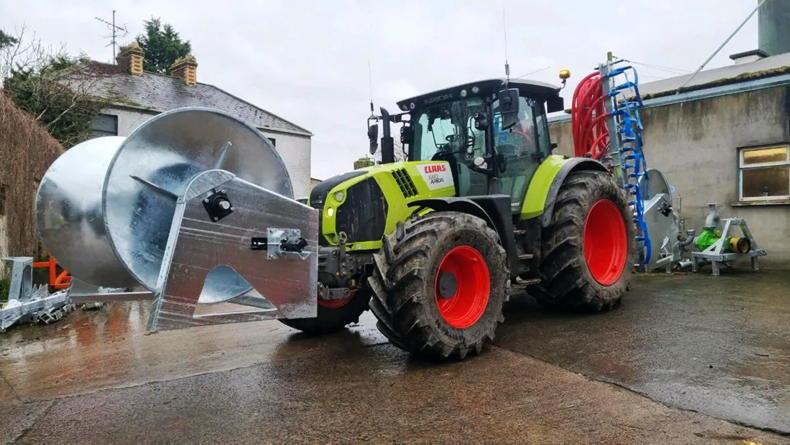
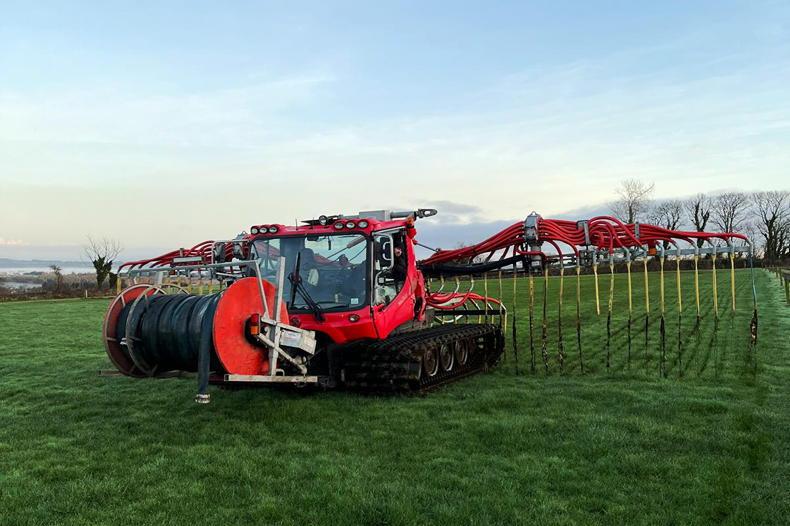
SHARING OPTIONS